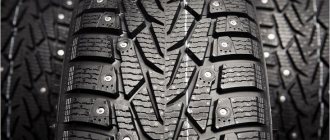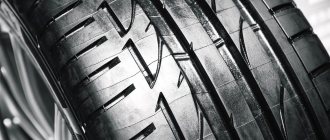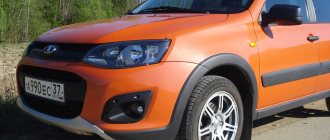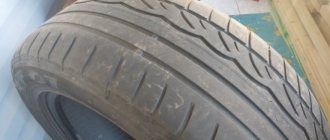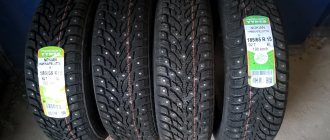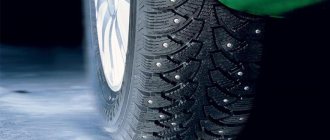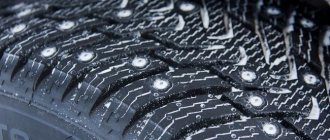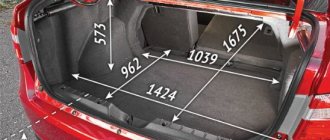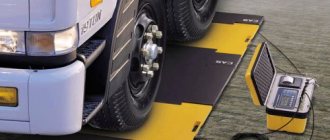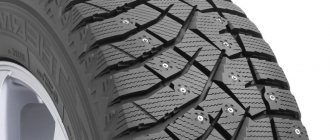The winter season has its own characteristics, including for road users. Winter tires are a mandatory requirement for all vehicles; failure to comply will result in penalties and create a dangerous situation on the road. The tread depth of winter tires is an indicator that every driver should monitor, especially if the tires are not new. The team of the publication "AutoFemida" will tell you how to determine the tread height of winter tires, and what requirements the traffic police imposes on them.
Tread depth of winter and summer tires
With a tread depth of 4 mm, the tire's grip on the road surface is reduced, especially on wet roads. Your tires may lose contact with the road, preventing you from braking or turning. Therefore, we advise you not to wait until the tread pattern wears down to the minimum permitted depth of 1.6 mm. Summer tires need to be retreaded with a tread depth of 2 to 2.5 mm, winter tires - 4 mm. Tread depth is measured at the deepest point of the grooves, elevations and fastenings have no significance in measuring tread depth.
Permissible tread height for a passenger car
According to the traffic rules, the maximum wear of the working part for passenger tires, according to the write-off rules, is no more than 1.6 mm. Depending on the design of the rubber product and the specific type of car, the tolerance may differ from the established standard to a greater extent, but not less.
What residual tread height is allowed on a winter tire?
The table above does not contain information about the minimum wear of the slopes in winter. New tires for passenger cars have a tread height of approximately 12-18 mm, which is determined by the pattern and the intended purpose of the product.
According to the regulations, tires intended for driving on snowy or icy areas cannot be used with a tire residue of less than 4 mm. In this case, the width and design of the product are not decisive.
Initial and permissible minimum tread depth for winter tires
- European. The main application is tread adhesion to wet asphalt and sleet. Therefore, they are cut by drainage channels and have a slightly directional wedge pattern. Thereby removing it for better drying of the contact patch between the tread and asphalt. They perform well on ice at low temperatures from -15˚C. Ideal for cities where roads are sprinkled with reagents to ensure slush removal. The tread depth of new winter tires is 5-6 mm on asphalt.
- Scandinavian. Serves to bite into frozen surfaces, providing better grip. This is ensured by a large number of rectangles and diamonds placed at a large distance. The presence of small stripes (lamellas) is very important. Thus, the machine pushes through the solid surface of the ice or crust. But this type of tire provides poor braking on wet asphalt.
Tire tread, what is it?
Several factors are responsible for the safe movement of a car, but one of the most key is the condition of the tire and the depth (aka height) of the tire tread. The tread height of a new tire directly depends on the purpose of the wheel and its size.
First you need to understand what a tire tread is. This term refers to grooves directed in different directions, differing in depth. They are located on the outer surface of the tire in areas of likely contact with the road surface. Its main function is (both on a passenger car and a truck) to remove snow and dirt from the tire's adhesion patch to the road surface and ensure efficient control.
Types of protectors can be divided into several types:
- Universal. Designed for both asphalt roads and rough terrain.
- Off-road. Designed for particularly slippery and snowy roads and have enhanced traction in difficult terrain.
- Smooth. Used exclusively for driving on race tracks.
Together with the chemical composition of the rubber mixture from which the tires are made, the tread guarantees the stability of the car while driving, and in the case of a non-studded tire, it plays a leading role in the car’s handling. Now we should consider the existing types of winter tires.
Winter tire tread depth
Wear should be even across the entire circumference of the tread, without sharp dents or irregularities.
A tire with uneven wear is not suitable for use. Over the entire circumference of the tread, wear should be uniform, without sharp dents or irregularities. A tire with uneven wear is not suitable for use.
In the field of car enthusiasts, there is an opinion that limiters are used in order to change and buy new tires more often... ... This is a misconception. The limiter warns that driving on these tires is dangerous.
Numerous tests of tires with tread less than 1.6mm show long braking distances on wet roads. The hydroplaning effect is activated, endangering the lives of the driver and passenger.
Winter tire tread depth indicator The optimal tread depth for winter tires is greater than for summer tires. Compacted snow is more difficult to remove from the wheel contact patch, so the grooves must be deeper.
For winter tires, the depth is 4 mm, but we note that this is the RECOMMENDED value.
Fine for improper use of tires in 2022
In 2022, Chapter 12 of the Code of Administrative Offenses does not contain references to the Technical Regulations of the Customs Union. Those. cannot be imposed for not having winter tires However, a draft of such a fine exists. You can find out more about it in this article.
However, there is a fine for using worn winter tires - 500 rubles (or a warning). This fine can be imposed on a driver using winter tires (marked M+S, etc.) whose tread depth at the most worn place is less than 4 mm. Please note that a fine is imposed only when operating a vehicle on an icy or snowy road surface.
Let's summarize this article:
- By law, you can change tires to winter ones from September to November.
- In practice, the choice of a specific date for replacement must be made taking into account weather conditions. However, I do not recommend changing tires later than November 15th - the unofficial day to change summer tires.
- There will be no penalty for using summer or all-season tires during the winter months in 2022 and 2022.
Source
What is the minimum permissible tread depth
With a tread depth of 4 mm, the tire's grip on the road surface is reduced, especially on wet roads. Your tires may lose contact with the road, preventing you from braking or turning. Therefore, we advise you not to wait until the tread pattern wears down to the minimum permitted depth of 1.6 mm. Summer tires need to be retreaded with a tread depth of 2 to 2.5 mm, winter tires - 4 mm. Tread depth is measured at the deepest point of the grooves, elevations and fastenings have no significance in measuring tread depth.
The pattern of each stripe is designed taking into account its place on the tread. Therefore, a tire with an asymmetric tread has an “outside” side and an “inside” side. And since such a “composite” pattern usually has at least one track with a directional pattern, such tires are divided into left and right, and are placed only on one of the two sides of the car.
The nature of the pattern divides the tread patterns into “European” and “Scandinavian”. A diagonally directed network of grooves, lamellas and lugs along the contour of the tread (shoulder) are the distinctive features of a pattern that is beneficial when driving in mild winter conditions, on roads cleared of snow, heated by intense road traffic. movements. The mixture of water, snow, and sand covering the asphalt is quickly removed from the contact patch of the “European” tread, and the shoulder elements come into play when deep snow passes.
Vehicle cross-country ability
A vehicle's cross-country ability is its ability to move on bad roads and in off-road conditions, as well as to overcome various obstacles encountered along the way. Passability is determined:
- the ability to overcome rolling resistance using traction forces on the wheels;
- overall dimensions of the vehicle;
- the vehicle's ability to overcome obstacles encountered on the road.
The main factor characterizing cross-country ability is the ratio between the greatest traction force used on the drive wheels and the force of resistance to movement. In most cases, the vehicle's cross-country ability is limited by insufficient traction between the wheels and the road and, therefore, the inability to use maximum traction force. To assess the vehicle's ability to pass on the ground, the coefficient of adhesion weight is used, determined by dividing the weight on the drive wheels by the total weight of the vehicle. Cars with all wheels are driving have the greatest cross-country ability. In the case of using trailers that increase the total weight, but do not change the adhesion weight, the cross-country ability is sharply reduced.
The amount of adhesion between the driving wheels and the road is significantly influenced by the specific pressure of the tires on the road and the tread pattern. Specific pressure is determined by the pressure of the weight of the wheel on the footprint of the tire. On loose soils, the vehicle's maneuverability will be better if the specific pressure is lower. On hard and slippery roads, traction improves with higher specific pressure. A tire with a large tread pattern on soft soils will have a larger footprint and a lower specific pressure, while on hard soils the tire will have a smaller footprint and the specific pressure increases.
Vehicle cross-country parameters
The vehicle's cross-country ability in terms of overall dimensions is determined by:
- longitudinal radius of passability;
- transverse radius of passage;
- the smallest distance between the lowest points of the car and the road;
- front and rear cross-country ability (approach and departure angles);
- horizontal turning radius;
- overall dimensions of the car;
- height of the car's center of gravity.
Permissible minimum tread depth for winter tires
For example, in Europe, tires with a tread depth of less than 3 mm are not allowed for use. But how can you determine whether it’s worth buying new “shoes” for your car or not? How to determine the tread height of new summer tires? To determine this parameter, there is a special device that allows you to effortlessly measure the required indicators.
But if you are an ordinary person, most likely you do not have such a device. But solving this problem is very simple: you just need to take an ordinary coin.
Insert it into the groove and mark with a black marker where the rubber ends. Then measure the depth of the coin using a ruler. You can also use a regular ruler to measure. If you are not a supporter of “handicraft” methods, you can also determine the degree of tire wear using a special indicator, which is made in the form of a separate protrusion on the tire.
The State Traffic Inspectorate indicated the tread depth for all vehicles
Truck Gazelles will be able to roll tires until the tread depth is less than 1.6 millimeters. "Gazelle" minibuses will have to change tires when the tread depth is less than two millimeters.
The corresponding bill was prepared by the Department of Road Safety of the Ministry of Internal Affairs of Russia. It was developed by order of the President, which indicated the need to establish uniform requirements in government regulations regarding the use of car tires when operating vehicles.
It can be assumed that the whole problem was in the Gazelles. The fact is that the rules of the road, in particular the provisions for authorization for the operation of vehicles, stipulate that the tires of passenger cars have a residual tread depth of less than 1.6 mm, trucks - 1 mm, buses - 2 mm, motorcycles and mopeds - 0.8 mm.
Truck Gazelles will be able to roll tires until the tread depth is less than 1.6 millimeters
"Gazelle", as well as the Korean Porter, are category "B" cars. Their maximum weight does not exceed 3.5 tons. That is, the tread depth should be 1.6 mm. However, in all other respects, these are trucks. They are designed for transporting goods. That is, they can roll tires down to one millimeter?
According to the requirements of the technical regulations on the safety of wheeled vehicles of Russia, according to the requirements of the same regulations of the Customs Union, they remain trucks. Category N1 - vehicles intended for the transportation of goods, having a maximum weight of no more than 3.5 tons.
In general, everything is very complicated with the classification of vehicles. What, for example, include pickup trucks? They also belong to category N1 in both international and Russian qualifications, despite the fact that many of them can be driven with an open category “B” license. Here cars are already divided according to their functionality. By the way, many pickup trucks are prohibited from entering the city center without the appropriate pass: the carrying capacity is more than a ton. Many of them can be driven with a category “C” license; their maximum weight is more than 3.5 tons.
Now, in accordance with the instructions of the President, the Ministry of Internal Affairs has decided to indicate the tread depths for each vehicle. For vehicles of category L - these are all mopeds, motorbikes, motorcycles, as well as motorcycles, scooters and even tricycles and quadricycles - the residual tread depth is set to at least 0.8 mm.
For vehicles of categories N2, N3, O3, O4 - these are trucks and trailers, the maximum weight of which is over 3.5 tons - 1.0 mm. For vehicles of categories M1, N1, O1, O2 - these are passenger cars, as well as trucks, the maximum weight of which does not exceed 3.5 tons, as well as trailers for them, which also do not exceed this weight - 1.6 mm.
Winter tires are marked with a symbol in the form of a mountain peak with three peaks and a snowflake inside it, as well as the symbols “M+S”, “M&S” and “MS”. If the tire has wear indicators, then there is no need to measure the tread depth with a caliper.
For vehicles of categories M2, M3 - these are buses, that is, everything with more than eight passenger seats - 2.0 mm. For the first time, the Basic Regulations for the admission of vehicles to operation spell out the requirements for winter tires and explain which tires are considered such.
The remaining tread depth of winter tires intended for use on icy or snowy road surfaces during operation on said surface is no more than four mm. Please note that we are talking specifically about their use in snowy or icy areas.
Winter tires are marked with a symbol in the form of a mountain peak with three peaks and a snowflake inside it, as well as the symbols “M+S”, “M&S” and “MS”. If the tire has wear indicators, then there is no need to measure the tread depth with a caliper.
What penalties will be provided for this is still unknown. It is clear that tires that do not meet these requirements will not pass inspection.
It is not yet clear whether penalties will be introduced on the roads. As the traffic police told us, we first need to introduce requirements, and then think about fines.
All-season tires - reality or myth?
It is mistakenly believed that today many car tire manufacturers offer so-called all-season tires. Allegedly, such tire options can be used both in winter and summer, without worrying about the quality of operation or fines from traffic police representatives on the road. In fact, this is another myth, inflated by ill-conceived tire advertising in our country. M+S (Mud and Snow) tires, which are considered all-season, have the following disadvantages:
- on a wet surface such tires behave simply disgustingly, the braking distance increases significantly;
- low temperatures cause changes in the chemical characteristics of the tread, increasing the wear of such tires;
- in summer the tires turn out to be too soft, and in winter they become quite hard and uncomfortable for travel;
- on snow, the M+S performs about the same as summer tires, so all-season performance is deceptive;
- at the traffic police post you will still be fined for not having winter tires on the wheels, which are designed specifically for winter;
- fuel consumption will increase significantly both in winter and summer, the tire will cause additional costs.
It should be noted that the term M+S comes from the world of off-road vehicles, where the designation Mud and Snow means the ability to travel on muddy surfaces and in snow. This does not mean that the manufacturer offers an all-season solution for passenger cars. But the glory of M+S's all-season capabilities is firmly ingrained in the thinking of our drivers, who strive to save on vehicle maintenance and operation. Therefore, we do not recommend using any all-season tire options. We invite you to watch a report on the quality of various tread patterns on winter tires:
What to pay attention to
- Tread Wear Indicators: Hard rubber indicators become visible as the tire wears. If they become noticeable, it's time to replace the tire. If you don't know where they are, look for a mark on the side of the tire that says;
- Tread height less than 1.6 mm : according to Russian and European legislation, the tread depth around the entire circumference of the tire should not be less than 1.6 mm for passenger cars.
For winter tires, Goodyear recommends a minimum tread depth of 4 mm. To check the tread depth, a special feeler gauge is used (commercially available and inexpensive). You need to measure the tread depth from different sides of the tire (inner and outer); - Foreign objects: often get stuck between tread pattern elements. Most of them can be easily removed from the tire surface. But if it seems to you that a stuck object (for example, a nail) has pierced the tire, do not remove it yourself, but contact a specialist at a service station. Otherwise, you risk being left with a flat tire;
Hard rubber indicators become visible as the tire wears.
If they become noticeable, it's time to replace the tire. Wear on the outside: If the tire is worn on both sides, it needs to be inflated and checked for air leaks. Losing tire pressure is a common occurrence, but driving on underinflated tires increases fuel consumption and increases the risk of an accident. More noticeable wear on the edges of the front tires indicates that you are not slowing down enough when cornering. It is very important to check your tire pressure regularly;- Center wear: If the tire is worn more in the center than on the sides, it means you are overinflating it. Too high a pressure can cause the tire to burst. Measure the pressure with a special pressure gauge and adjust it to the recommended level;
- Uneven wear on one tire: Patterns of tread wear may indicate problems elsewhere. Uneven scuffs and bald spots may mean the rims need to be balanced or rolled. Sometimes abrasions occur due to wear on the shock absorbers or a malfunction in the suspension;
- Uneven wear on all tires: Tires always wear at different rates. The engine is located in the front part of the car, which takes on most of the load when driving, so the tires on the front axle wear out faster. If you think they are wearing out faster than normal, check the condition of the suspension. If the tires are wearing more noticeably on one side of the car, it's time to check your wheel alignment;
- Jagged "pattern" on tire ribs: A jagged or feather-like pattern on the edges of a tire is caused by uneven friction against the road surface. This indicates that the wheels need to be adjusted.
Remaining tread height of passenger car tires
The residual or minimum tread depth for tires intended for winter use is regulated by the “Road Rules”
This quality is extremely important for the machine, therefore, in order to avoid accidents and accidents, it is necessary to comply with the permissible depth indicator
Tires for cars that no longer correspond to the presented parameter must be changed in a timely manner. If a car owner violates this rule, then there is a risk of receiving a fine from a patrol police inspector.
On a note! To regulate the wear rate, there is a rule - tires should not be worn more than 50 percent of the original value. Almost all manufacturing companies supply special wear marks or indicators with the product. This is done for the convenience of motorists, so that the indicator can be checked at any time.
In addition, the uniformity of tire abrasion is of great importance. Manufacturers use a special color layer, by which uniformity can be determined. In this case, the measurement takes place along the entire perimeter of the product. If the car enthusiast has determined uneven wear, it is necessary to check the wheel alignment parameter.
However, constant visual monitoring by the car owner of the condition of the tires is also of great importance. It is necessary to periodically inspect the products for the following damage:
- cracks;
- cuts;
- various surface breaks;
- mechanical damage;
- bumps and all sorts of other damage.
Note! If any external defects or damage to the rubber surface are found, it must be replaced immediately.
Special mark for measuring tire wear. Great attention must be paid to those wheels that are driving. After all, they bear the main burden
The appearance of surface damage on them is unacceptable. In addition, if one tire needs to be replaced, both wheels on the axle must be replaced.
Tire surface wear depends on the following:
- natural wear of tires due to loads and intensive use;
- incorrect alignment of wheels and tires, leading to uneven wear;
- inconsistency with the seasonality of tires;
- high mileage;
- incorrectly selected type of tires;
- driving too fast on ice, potholes and off-road conditions;
- aggressive driving style;
- lack of control of correct tire pressure.
Check tread wear
Drivers tend to overestimate the condition of their winter tires. To avoid inaccurate assessment of tire condition by eye, Nokian Tires has developed a special wear indicator DSI (Driving Safety Indicator), which allows you to accurately assess the remaining tread depth - it displays the tread groove depth in millimeters and allows you to clearly determine whether the tire meets safety and safety requirements. How large is the remaining tread depth?
Checking with a match
Tire safety can be measured using an ordinary five-centimeter match with a 3-4 mm sulfur head. When placing a match into the tread groove, the head should disappear from view. Check at several points on the tire surface.
If the wax does not disappear completely, the tread is not safe for driving in winter conditions. 4 mm is the minimum tread depth recommended by Nokian Tyres. The law stipulates a tread depth requirement of 4 mm for winter tires and 1.6 mm for summer tires.
Checking with a two euro coin
An even better tool for checking the condition of your tires is a two-euro coin. The width of the silver rim of the coin is less than four millimeters. If it rises even slightly above the tread block when a coin is placed in the groove, it makes sense to consider replacing the tires.
How to assess the degree of wear?
In addition to the visual test, there is a more accurate modern way to determine the level of wear.
Method No. 1.
For this, an electronic meter is used. There is one at the service station.
rice. Measuring device
It gives results accurate to a few microns, or calipers. If you don't have any of the above devices with you, you can use a coin or other object to measure.
Depth is measured along the main grooves.
Please note that the size of the geometry must be the same around the entire circumference. If the edge-to-center difference is significant, it may indicate improper air pressure, suspension failure, or an overly aggressive driving style.
Method No. 2.
It is quite intuitive and does not require special equipment. All he needs is an ordinary coin.
rice. Coin check.
It is enough to insert the coin vertically into the individual recesses. When the gold rim is completely hidden in them, the valid block value is preserved. It is advisable that inspection be carried out at several points, including both longitudinal and transverse grooves.
Thanks to this, it is checked whether the entire surface provides a safe value and whether the tire wears evenly during operation.
Method No. 3.
Measurement with miniature calipers. The principle of operation is simple. The measuring line is located at the bottom of the individual grooves.
rice. Measured using a caliper.
The top of the sensor is fixed to the top of the blocks. In this case, just like when measuring with a coin, you must remember to test in all grooves and at different points on the surface. Only then will the research be sufficiently reliable.
Constantly monitor the condition of studded tires
If the studs are still held in the tire, but at the same time swing from side to side, then the grip of the tire is significantly reduced.
If the studs are still held in the tire, but at the same time swing from side to side, then the grip of the tire is significantly reduced. A bendable spike will not cut into ice and has weak grip on slush and snow. Particularly dangerous are cases where a large number of studs have become loose and the number of studs in the tires varies.
According to the winter tire law, the maximum permissible variation in the number of studs between tires is 25%. This is useful for assessing the safety of your tires, but the results will always be a little inaccurate and unreliable, especially since drivers tend to overestimate the condition of their tires. That's why Nokian Tires has developed a tread wear indicator (DSI) for its new tyres, which accurately displays the remaining tread depth and the distance at which the tires will continue to provide adequate safety.
How to understand tire designations?
The tire size is the most important information printed on the tire. The size is indicated by numbers and letters, e.g. 195/65 R15 91H, where:
- 195 – tire width, mm
- 65 – tire height, % of width
- R15 – wheel arch diameter (landing diameter)
- 91 – load index
- H – speed index
- The speed index determines the maximum speed capabilities of the tire. The most important speed indices:
- Q – 160 km/h
- S – 180 km/h
- T – 190 km/h
- H – 210 km/h
- V – 240 km/h
- W – 270 km/h
All tires have markings that can be used to determine whether the tire meets EU, US, or both standards. The letter E, inscribed in a circle with two numbers, indicates that the tire has been tested in accordance with the safety requirements in force in the European Union. The American standard is designated DOT (Department of Transportation).
If tires are certified to both standards, they have both E4 and DOT designations. M+S: mud (Mud) + snow (Snow) – winter and all-purpose tires. AW (Any weather) are universal tires, as are AS (All Seasons). Some businesses use pictograms instead of letters: sun, rain, snowflake. An arrow on the side of the wheel indicates the direction of rotation of the tire.
The year of manufacture on the tire is indicated by four numbers: week and year of manufacture. For example, 1509: the first two digits are the fifteenth week (15), 09 is the year of manufacture (2009).

